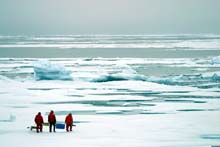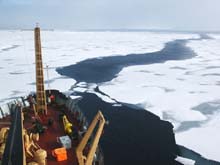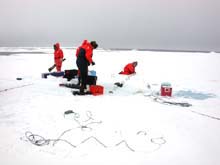
The science team carries their equipment to a sample site away from the Louis St-Laurent in an effort to obtain samples that will not be affected by the ship's presence.
Physical Nutrients and Primary Productivity
Terry Whiteledge
Professor
Institute of Marine Science
University of Alaska, Fairbanks
Overviews
The waters in the Arctic Ocean have not been studied as much as the other oceans because of the difficulty of collecting samples in the cold temperatures and thick ice cover. As a result, we have only recently started to understand how the plant and animal organisms can survive in such a harsh environment. Nearly 40 years ago, water and organisms were sampled from a drifting ice island (known as Fletcher’s ice island or T3) as it meandered around the Arctic Basin. The semi-permanent science station was manned for several years and produced most of the early data. However, recent improvements in sampling from icebreakers and nuclear submarines have greatly improved our knowledge of fertility of Arctic Ocean water and the growth of plankton and algae in the water column and ice. However, there is still much that is unknown about the biota of our northern most ocean. This Arctic exploration cruise will greatly improve the knowledge of the interactions of water currents, nutrients and other conditions required for growth of plankton in the water for comparison with sea ice communities. At the end, we want to better understand the food that is available to feed all of the animals that live in the Arctic Ocean.

A view from the bow of the Louis St-Laurent shows a lead. Ice leads are cracks in the thick ice cover that vessels use because it minimalizes time spent breaking through the ice.
The Problems of Collecting Samples
Collecting samples of ice and water in the Arctic is often challenging and dangerous. When large icebreakers are used, many areas of the Arctic Ocean can be sampled, but the ice conditions are often too difficult for them when large ridges of broken ice form. These ridges may be 30-40 feet high and may extend to almost 100 feet below the surface. The ice in the Arctic is very hard, so icebreakers must go very slowly as they travel to the sampling stations. Often, the icebreakers may only travel 1-2 miles per day when thick ice is encountered. Helicopters are normally used to look for cracks in the ice called leads (pronounced as “leeds”). If a good lead can be found, several additional miles may be covered each day. Once the ship arrives at the sampling station, there still remains the difficulty of obtaining water and ice samples. If the ice is thin, the ship may be able to create a hole through which sampling gear can be lowered. The ship and ice are in constant motion due to the wind and water currents, so the hole in the ice may disappear rather quickly and the sampling gear may be lost. Scientists and equipment may be lowered to the ice to collect samples if conditions are safe. Small holes are drilled into the ice with augers to collect ice samples and may be used to lower water sampling bottles into the water below. Collecting samples on the ice is difficult, but is often the best way to obtain samples that are not affected by the large ship.

These specially designed traps isolate the shrimps and crabs inside from light and elevated water temperatures as they are brought to the surface. Click image for larger view.
Dissolved Nutrients- The fertilizer in Seawater
The nutrients dissolved in seawater are similar to the fertilizer used to feed a lawn. The nitrogen, phosphorus, and silicon nutrients are used by the tiny single-celled plants to grow. The amount of nutrients in various parts of the ocean varies, depending on ocean currents and proximity to land. Many of the nutrients are derived from the weathering of rocks on land and carried into the ocean by rivers. As a result, many of the nutrient rich oceanic areas are near river mouths. The nutrients can also be re-cycled in the ocean with the decay of plant and animal matter by bacterial processes. In general, disolved nutrients have the highest concentrations close to land or deeper in the ocean. The Arctic Ocean receives nutrients from the currents flowing from both the Atlantic and Pacific oceans and from the various rivers. The nutrient concentrations in the water flowing from the Atlantic Ocean are smaller that those from the Pacific Ocean. The nutrient concentrations, therefore, can often be used to identify the origin of the water.
Growth of Plants in Ice-covered Waters
The growth of the single-celled plants in the ocean known as phytoplankton requires nutrient and sunlight to support the process known as photosynthesis. Obtaining enough sunlight to grow is a big problem for phytoplankton in the Arctic Ocean. During several of the winter months, the sun does not rise above the horizon, so very little sunlight is available. In addition, the snow and ice covering the water often absorb or reflect most of the sunlight during the months with sunlight. During the summer months when the snow cover melts and holes in the ice appear, is the only period when quite a lot of sunlight is available for the phytoplankton to grow. Early estimates of phytoplankton growth rates from the T3 ice island indicated that the Arctic Ocean had the lowest values of all the oceans. More recent measurements have indicated that the early values were underestimated by a factor of 2-10. The Arctic Exploration cruise will take special efforts to obtain phytoplankton growth rates under the ice and in open water leads. These measurements will be compared to plankton growth rates measured inside the ice.
Sign up for the Ocean Explorer E-mail Update List.


























